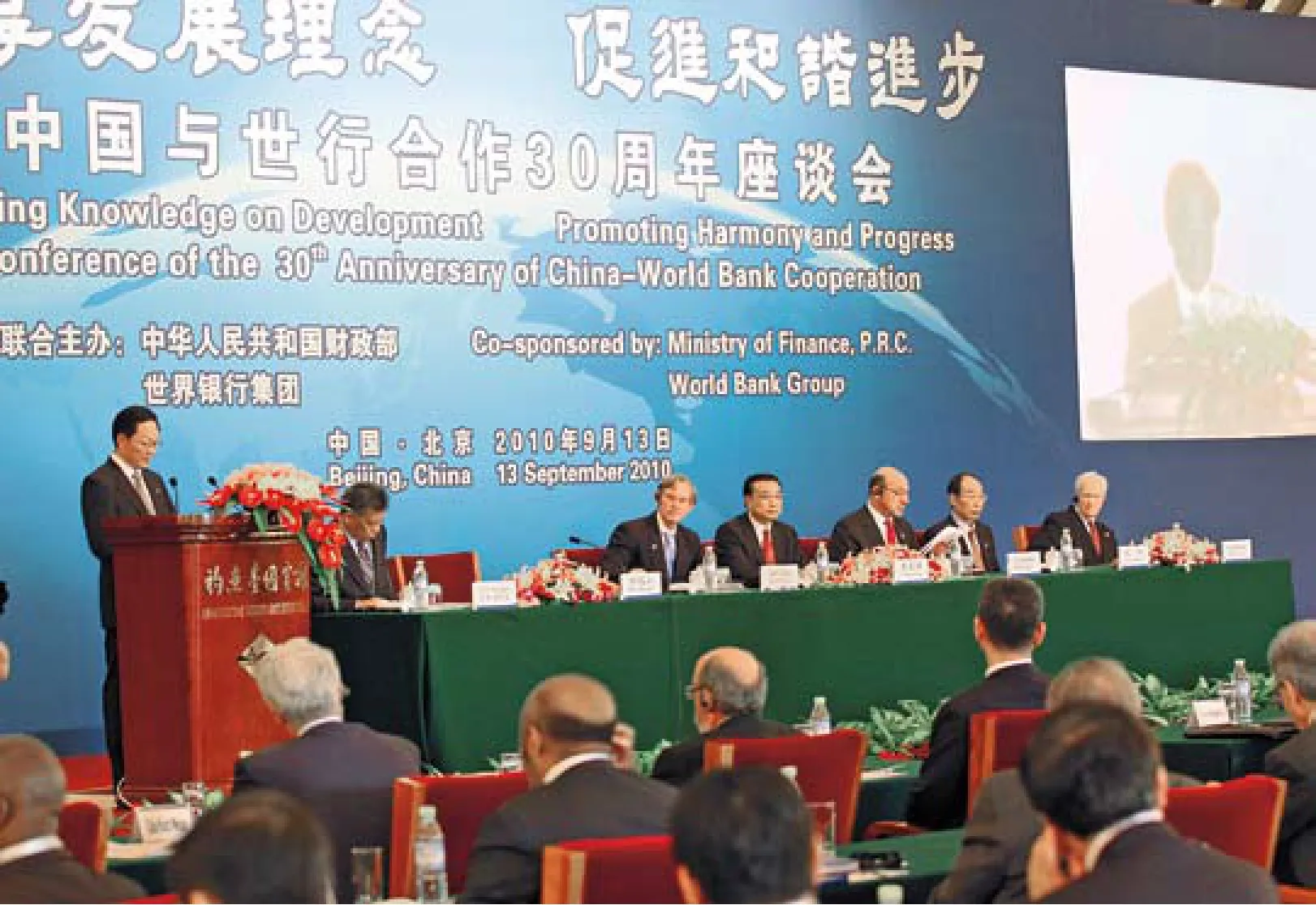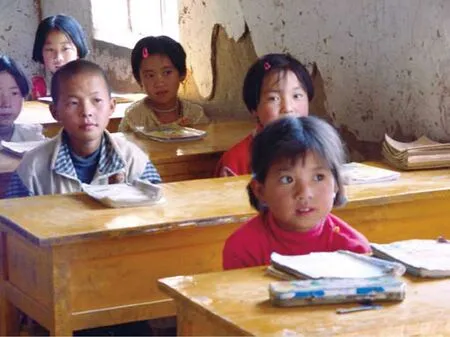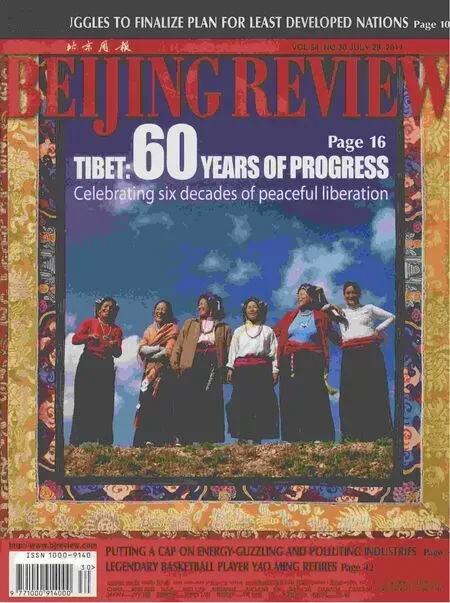A Prosperous Association
2011-10-14ByHUYUE
By HU YUE
A Prosperous Association
By HU YUE

RED BRIDGE, GREEN PROJECT: The World Bank-financed Anhui Tongling-Huangshan Highway features environment-friendly construction and protection of plant life along the way
China and the World Bank celebrate three decades of assistance and shared learning
This year marks the 30th anniversary of the China-World Bank Group partnership, a major component of the country’s roaring economic machine.
While China gleams with vibrant economic growth and significant poverty reduction, the World Bank is recognized for its active supporting role in the country’s development. By June 30, 2010, the World Bank’s cumulative lending commitments to China had exceeded $47.41 billion for a total of 323 projects involving transportation, energy efficiency, urban construction and environmental protection.In its latest move, the World Bank extended fi nancing of $4.788 million to help reduce rural and agricultural pollution in the East China Sea.
But, loans aside, knowledge has proved to be the most important aspect of the partnership as the bank has been sharing development experiences, management expertise and cutting-edge technologies with China, customizing them to the country’s needs.
By any measure, the arrangement has been fruitful. In the past three decades,China has the highest success rate for World Bank projects and is now firing ahead economically while developed economies falter.
In addition, China’s poverty rate fell sharply to 10 percent in 2004 from 65 percent in 1981. Since 1995, the bank has disbursed around $800 million in credit to China’s poverty alleviation projects, bene fi ting more than 8.7 million poor residents in central and west China, said He Xiaojun,Deputy Director of the International Poverty Reduction Center in China.
“The key to the success of the China-World Bank cooperation is the country’s remarkable ability to utilize global knowledge and expertise of the World Bank to move its own reforms forward,” said World Bank President Robert Zoellick at a press conference on September 16 in Beijing.This was his fourth official trip to China since he took of fi ce as the bank’s chief in July 2007.
“The bank’s fi nancial and management prowess has allowed China to gain strength and laid the groundwork for the country’s economic takeoff,” said Xie Xuren,Minister of Finance of China.
Joining forces
The seed of the partnership was planted in April 1980 when then Chinese Vice Premier Deng Xiaoping and World Bank President Robert McNamara first met in Beijing.
“We are poor, and we have lost touch with the world,” Deng told McNamara.“We need the help of the World Bank to catch up.”
But Deng couldn’t have imagined how the World Bank would come to embrace China, let alone the fact China would one day become a donor instead of a debtor nation.
In the early years, China looked to the bank for project financing, technical assistance, as well as management methodologies. When it helped build the Lubuge Hydropower Station in southwestern Yunnan Province in 1984, the World Bank introduced the system of international bidding for large civil projects in China.Before this, government contracts were mostly awarded through direct contracting,without any competition. The Lubuge project demonstrated impressive cost saving and quality improvements, and as a result the bidding system began to fi nd wider use in the country.
Like many other enduring ties, the China-World Bank partnership has evolved with time. As the projects in China developed, the learning became mutual.
“The World Bank has learned from the ways China fine-tuned its projects,” said Zoellick. “These are achievements that have not only bene fi ted China but also the East Asia region more widely and even the world.”
Since 2005, around 70 percent of World Bank activities in China have had an environmental objective as the country has embarked on the road of a green economy. Besides this,around 70 percent of the bank’s loans for China went to underdeveloped northeastern and western regions in a bid to help bridge the geographic wealth gap.

JOINING HANDS:The Ministry of Finance and the World Bank Group co-sponsored a conference on September 13 to mark the 30th anniversary of the partnership. Robert Zoellick (third left), China’s Vice Premier Li Keqiang(fourth left) and Minister of Finance Xie Xuren (first left)attended the conference
The World Bank Group’s current assistance program aims to help:
1. Integrate China into the world economy, by deepening its participation in multilateral economic institutions, reducing internal and external barriers to trade and investment, and contributing to its overseas development efforts
2. Reduce poverty, inequality and social exclusion, by promoting balanced urbanization, sustaining rural livelihoods,and expanding access to basic social and infrastructure services, particularly in rural areas
3. Manage resource scarcity and environmental challenges,through reducing air pollution,conserving water resources and optimizing energy use
4. Deepen financial intermediation, by expanding access to financial services (especially among small and medium-sized enterprises), developing the capital market, managing systemic risks,and maintaining financial stability
5. Improve public and market institutions, by improving firm competitiveness, reforming public sector units, and rationalizing intergovernmental fiscal relations
China’s achievements have attracted the attention of the world, and many developing countries are turning to China for knowledge and ideas, Zoellick said.
Now, the World Bank can draw from China’s experience—whether in infrastructure, education, rural development, forestry or energy—and employ this knowledge with other countries to overcome poverty in the world, he said.
The annual China-Africa high-level experience sharing conference jointly hosted by China and the World Bank is now a platform for China and African countries to share lessons and facilitate project coordination.
“Some Chinese manufacturers are relocating to Southeast Asia where labor and land costs are more affordable,” Zoellick said. “So we are exploring the possibility of attracting those enterprises to Africa and building special economic zones for them.”
Upgraded status
China’s role at the World Bank has also changed over the years. In December 2007, China contributed $30 million to the International Development Association(IDA), which provides grants and no-interest credit to the world’s poorest countries.The donation was China’s fi rst contribution to the IDA. Since 1981, China has received more than $9.9 billion in IDA credits to support priority projects and strengthen capacity and institutions. China stopped being an IDA client in 1999 when its growing prosperity quali fi ed it for more marketbased terms from the World Bank.
In 2009, China purchased $1.5 billion in private placement bonds of the International Finance Corp., a private sector lending arm of the World Bank, in an effort to boost global trade fi nancing.
This transition was followed by yet another important milestone in April 2010 when China gained a louder voice at the bank. Under the bank’s reform, China’s voting power was increased to 4.42 percent from 2.77 percent, the third largest in the 186-nation anti-poverty lender.
“This new role comes with many opportunities, responsibilities and expectations,” said Zoellick. “China will need to weigh how it can best contribute as a responsible stakeholder in the international system.”
China’s in fl uence will be felt in designing effective climate change policies, ensuring steady global growth, and providing development resources and investment to overcome poverty in other countries, he said.
“This increased representation re fl ects China’s growing economic clout and paves the way for the country to assume greater responsibility in world economic affairs,”said Justin Yifu Lin, chief economist of the World Bank.
The next steps
Looking ahead, the World Bank vowed to tighten its partnership with China andhelp it tackle new challenges, including poverty reduction, economic rebalancing and environmental protection.

(Left)SUPPORTING EDUCATION:As part of the World Bank’s Basic Education project in west China,the northwest Ningxia Hui Autonomous Region has received $21.5 million in loans from the bank

CULTURAL COMMITMENT:A group of Buyi ethnic minority women visited the Guizhou Guanling National Fossil Geopark on December 8, 2009, where a World Bank project was initiated to protect southwest Guizhou Province’s cultural relics and restore ancient buildings
“China’s quest now is to join the ranks of high-income countries in the next 15 to 20 years while also protecting its environment and natural resources,” said Zoellick.“But experience shows that transitioning from the middle income to high income status can be harder than from low income to middle income.”
During the 12th Five-Year Plan period(2011-15), China will focus more on developing its greatest asset—its people—by emphasizing education, open innovation and social security and health care systems,he said. “At the same time, we are likely to see more emphasis on energy ef fi ciency and emission reduction.”
Zoellick said that the World Bank would work with China to help it fi nd a better balance between domestic demand and exportled growth, consumption and investment,rural and urban development, and the growth of its interior and coastal economies.
Minister Xie said China has a long way to go toward prosperity, and still needs help from the World Bank in terms of technological assistance and knowledge transfer.
The next step of the partnership is to strengthen cooperation ef fi ciency, place the focus on quality instead of quantity of project loans, and help other developing countries through the World Bank, he said.
